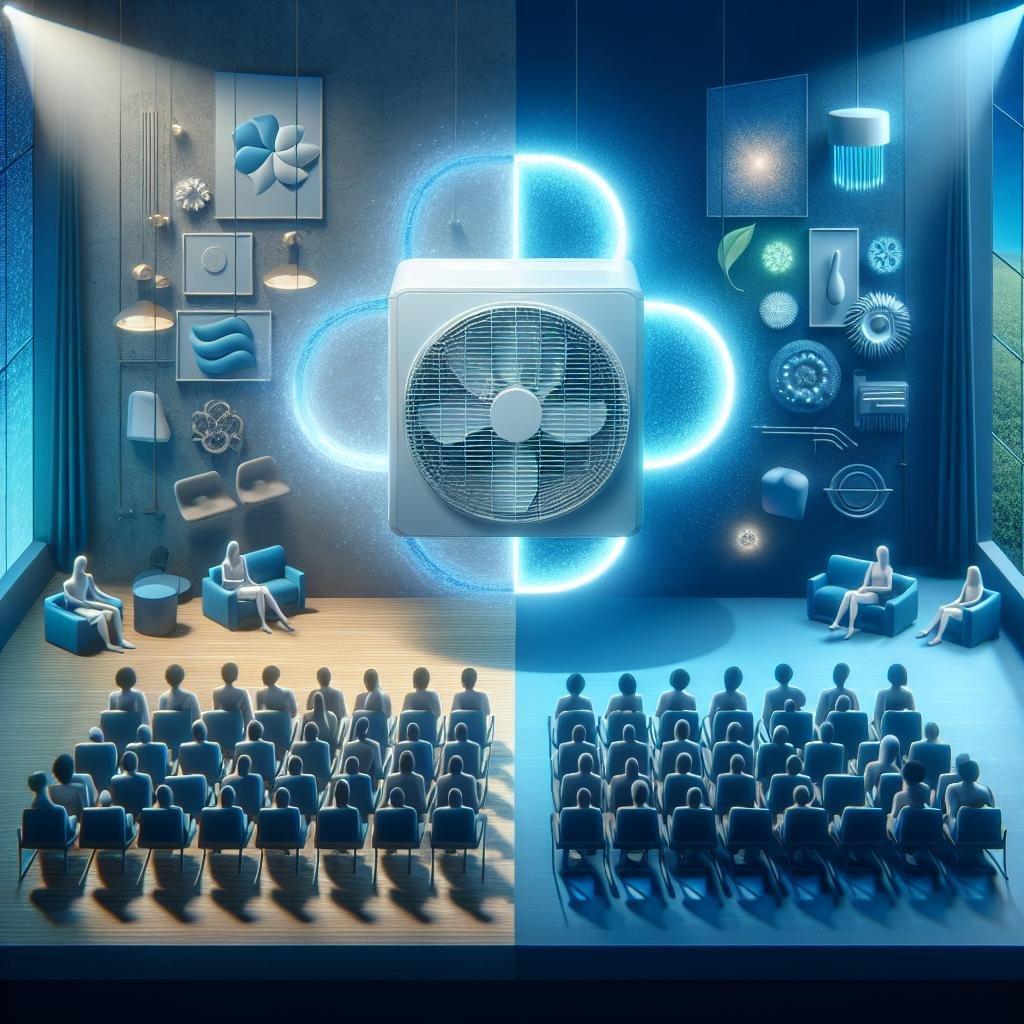Mini Split AC for Theaters and Performance Spaces: Enhancing Audience Experience
In the world of live entertainment,every detail counts. From the flicker of stage lights to the precision of sound, each element contributes to an experience that captivates and transports audiences. Yet, amid the carefully orchestrated ambiance, one critical aspect often goes unnoticed: the air conditioning. For theaters and performance spaces, the balance of comfort and climate control is essential—not just for the performers but for the audience, whose enjoyment hinges on more than just what happens on stage. Enter the mini split air conditioning system, a elegant solution that combines efficiency with versatility, transforming these venues into inviting sanctuaries for culture and creativity. This article explores how mini split AC units are revolutionizing temperature management in theaters, enhancing the overall experience for audiences and performers alike while maintaining the artistic integrity of the performance space.
The Importance of Climate Control in Theaters and Performance Spaces
Creating a comfortable environment in theaters and performance spaces is crucial for enhancing the overall audience experience. Climate control systems not only regulate temperature but also contribute to the acoustic quality of the performances. By maintaining an optimal atmosphere, theaters can ensure that patrons remain engaged, attentive, and fully immersed in the artistic presentation. The integration of mini split air conditioning units represents a practical and efficient solution that addresses diverse climate challenges, from sweltering summers to brisk winters. The discreet design of mini splits ensures that the aesthetic integrity of the venue remains intact, while providing targeted climate management that caters to varying areas within the space.
Moreover, effective climate control systems can prevent common disruptions that arise from uncomfortable temperatures, such as distracted audiences or poor acoustics. By utilizing efficient zoning features, mini split systems allow for customizable temperature settings tailored to specific sections of the venue, enhancing comfort without overspending on energy costs. Consider the following benefits that contribute to a well-regulated environment:
- Improved Air quality: Enhanced filtration systems reduce allergens and toxins.
- energy Efficiency: Mini splits utilize less energy than traditional HVAC systems.
- Quiet Operation: Designed to operate silently, minimizing audio disruptions.

Optimizing Airflow and temperature for Comfort During performances
Creating the right atmosphere during performances is paramount for both performers and the audience. Proper airflow and temperature adjustments help maintain comfort, which can significantly impact focus and engagement. By implementing a mini split AC system, theaters can control the indoor climate effectively, allowing air to circulate freely while avoiding the traditional hot or cold spots associated with traditional HVAC systems. The flexibility of mini splits allows for tailored configurations that address the unique needs of various spaces, ensuring a consistent temperature that supports the emotional tone of the performance.
Key benefits of optimizing airflow and temperature include:
- Consistent Comfort: Audience members are more likely to remain engaged when they are not distracted by discomfort.
- Enhanced Performance Quality: Comfortable performers can deliver more compelling performances,as they are less likely to be affected by heat or cold.
- Versatility: Mini split systems can easily adapt to different configurations or setups, making them ideal for stage productions that change frequently.
A thoughtful approach to airflow can also reduce the risk of sound distortion, particularly in intimate performance settings. The following table summarizes optimal airflow considerations:
| Aspect | Recommendation |
|---|---|
| Temperature Setting | 68°F – 72°F for optimal comfort |
| Airflow Direction | Ensure even distribution; avoid direct flow on stage |
| Humidity Levels | Maintain between 40% – 60% for comfort and air quality |

Energy Efficiency and Cost-Effectiveness of Mini Split AC Systems
When considering the installation of mini split AC systems in theaters and performance spaces, energy efficiency plays a vital role in both sustainability and cost management. These systems are known for their ability to provide precise temperature control while consuming significantly less energy than traditional air conditioning units. The use of inverter technology in mini splits allows them to adjust their output to match real-time cooling needs, which translates into notable energy savings. Over time, this efficiency can lead to reduced energy bills, making them a financially sound option for venues that require efficient climate control without sacrificing comfort.
Additionally, the cost-effectiveness of mini split systems extends beyond just energy savings. Maintenance requirements are generally lower,which means fewer unforeseen costs related to repairs and upkeep. Key benefits include:
- Easy Installation: No ductwork required, reducing labor costs and installation time.
- Flexible Zoning: Allows individual control of different areas, enhancing comfort while conserving energy.
- Lower carbon Footprint: By reducing energy consumption, theaters can contribute to environmental sustainability.
investing in mini split AC systems is more than a trend; it is a strategic move towards a more efficient, cost-effective operational model that enhances audience experience in any performance space.

Choosing the Right Mini Split System for Unique Venue Designs
When selecting a mini split system for unique venue designs, consider the intricacies of your space to ensure optimal comfort and efficiency. shape and size play crucial roles in determining the necessary BTUs to effectively cool or heat your venue. Additionally, the layout of your performance space can influence the placement of indoor units. Think about features like seating arrangements and stage locations which impact airflow distribution. To identify the most suitable system, assess the following factors:
- Sound considerations: Opt for models with quiet operation to avoid distracting the audience during performances.
- Zone control: Select systems that allow for individual temperature settings in different sections of the venue.
- aesthetics: Choose designs that can blend seamlessly with the architecture, possibly using concealed or ducted options.
Also, evaluating energy efficiency is essential not only for reducing costs but also for minimizing environmental impact. Look for systems with high SEER ratings to ensure you’re investing wisely in long-term performance. Utilizing a multi-zone system allows you to cater to distinct areas within the venue while maintaining uniform comfort. For clarity, consider the following table showcasing key factors in system selection:
| Feature | Consideration |
|---|---|
| Noise Level | Low decibel ratings for undisturbed performances |
| Temperature Control | Individual settings for different zones |
| installation Type | Wall-mounted, ceiling-mounted, or ducted for aesthetic value |
| Energy Efficiency | Prioritize high SEER ratings for cost-effectiveness |
Q&A
Q&A: Mini split AC for Theaters and Performance Spaces: Enhancing Audience Experience
Q: What is a mini split AC system, and how does it differ from traditional HVAC systems?
A: A mini split AC system, also known as a ductless system, consists of an outdoor compressor unit and one or more indoor air handling units. unlike traditional HVAC systems, which rely on ductwork to circulate air, mini splits directly deliver cool or warm air into specific areas, allowing for targeted temperature control. This flexibility makes them ideal for theaters and performance spaces, which often have varying occupancy and usage levels.
Q: Why is climate control particularly crucial in theaters and performance spaces?
A: The atmosphere in a theatre significantly impacts the audienceS experience. An uncomfortable temperature can distract from performances. Additionally, the presence of lights, costumes, and large crowds can elevate the indoor temperature quickly. Effective climate control not only ensures comfort but can also enhance acoustic performance, making mini split systems a great choice for maintaining an optimal environment.
Q: What are the main advantages of using mini split AC systems in these venues?
A: Mini split systems offer several advantages, including energy efficiency, ease of installation, and quiet operation. Their zoning capabilities allow different areas of the theater to be cooled or heated independently, accommodating varying audience sizes and performing schedules.Plus, because they do not require ductwork, installation is less invasive, preserving the aesthetics of the performance space.
Q: Can mini split AC systems help with air quality in theaters?
A: Yes, they can! Manny mini split systems come with advanced filtration options that help reduce allergens, dust, and pollutants in the air.Improved air quality enhances the overall audience experience by promoting comfort and safety, particularly important in enclosed spaces that host large gatherings.
Q: What considerations shoudl venues keep in mind when installing a mini split AC system?
A: Venues should assess their specific cooling and heating needs based on the size of the space, expected occupancy, and the types of performances held. Consulting HVAC professionals is crucial to determine the right capacity and configuration. Additionally, aesthetic considerations—ensuring that indoor units blend seamlessly with the surrounding decor—should not be overlooked.
Q: Are there any downsides to using mini split AC systems in performance spaces?
A: While mini split systems offer many benefits, potential downsides include the upfront costs for installation and the need for regular maintenance to keep the units running efficiently. Moreover,the visible indoor units may require thoughtful placement to avoid obstructing sightlines or detracting from the performance atmosphere.
Q: How can theaters measure the effectiveness of their mini split AC systems?
A: The effectiveness of a mini split AC system can be measured by audience feedback regarding comfort levels, tracking energy bills for any changes in consumption, and monitoring the system’s performance, including temperature consistency and noise levels. Regular assessments will ensure that the system meets both cooling needs and operational efficiency.
Q: Is the use of mini split AC systems in theaters a trend, or is it becoming a standard practice?
A: The use of mini split AC systems is increasingly becoming a standard practice in theaters and performance spaces. As venues seek to optimize energy efficiency and improve audience experience, these systems are recognized for their versatility and effectiveness. With ongoing technological advancements, their popularity is likely to grow even further in the performing arts sector.
—
By addressing these questions, we hope to shed light on how mini split AC systems can significantly enhance audience comfort and experience in theaters and performance spaces.
Key Takeaways
As the curtains draw to a close on our exploration of mini split AC systems and their impact on theaters and performance spaces, it becomes evident that the true art of performance goes beyond the stage. The atmosphere—the air that envelops the audience—plays a pivotal role in crafting unforgettable experiences. By integrating mini split AC systems, venues can ensure that comfort and climate control do not overshadow the brilliance of the performance but rather enhance it.
As we move forward in a world that values impeccable audience experience, it is indeed the small yet significant innovations, like these versatile cooling solutions, that can truly elevate the magic of live performances. After all, a captivated audience is the heartbeat of any show, and with the right temperature, every laugh, gasp, and cheer reverberates even louder.
So, as we bid farewell to our discussion today, let us embrace the future where the blend of technology and artistry creates a seamless experience, allowing both performers and spectators to thrive in perfect harmony. Here’s to cool breezes and hot performances—may every seat be filled and every moment cherished!

